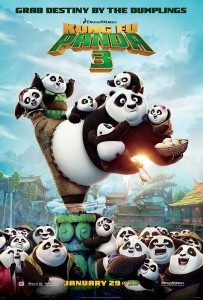When Po’s long-lost panda father suddenly reappears, the reunited duo travels to a secret panda paradise to meet scores of hilarious new panda characters. But when the supernatural villain Kai begins to sweep across China defeating all the kung fu masters, Po must do the impossible—learn to train a village full of his fun-loving, clumsy brethren to become the ultimate band of Kung Fu Pandas!

KUNG FU PANDA 3 takes full advantage of DreamWorks Animation’s breakthrough technical advances, while making history as the first production to create two different films, in English and Mandarin, with the same story and characters.
According to Jack Black, who once again voices the iconic role, that scene points to the fact that “Po is no Shifu, let’s be honest. He’s freaking out and doesn’t think he’s up to these new responsibilities, which are weighing him down even more than the countless dumplings he consumes.”
Black embraced the opportunity to revisit one of his most treasured movie characters and found it easy to reclaim his inner-Dragon Warrior. “I just go back to a younger me, when I was starting my career,” he explains.
Po has no bigger fans than the filmmakers who have brought him to life. Director Jennifer Yuh Nelson, who’s been with Po from the very beginning of his journey identifies with Po and his journey, which in some ways mirrors her own. Just as Po transitions from student to teacher, Yuh Nelson made a big move with Kung Fu Panda 2, on which she took the directorial reins after serving as head of story on the first picture, and as a story artist on other DreamWorks Animation films.
Whatever the obstacles, Po never gives up. “He’s got a great attitude,” says screenwriter Glenn Berger. “Po is very positive and unrelenting, and no matter how many times he falls, he keeps getting back up.”
The victims of Po’s instruction are Monkey (voiced by the legendary Jackie Chan), whose mischievous and playful nature masks a cunning martial arts ability; Crane (David Cross), the pragmatist of the group; Mantis (Seth Rogen), the smallest and most temperamental of the Five; Viper (Lucy Liu), the team’s “mother hen”; and Tigress,the strongest and boldest of the Furious Five. Returning to voice Tigress is Oscar® winner Angelina Jolie Pitt, whose spirit and talents imbue Tigress with power, outspokenness, directness and compassion.
Making the transition from student to teacher isn’t the only upheaval in Po’s life. His long-lost biological father, Li, has made his way to the Valley of Peace and to an emotional and hilarious reunion with Po. Acclaimed “Breaking Bad” star Bryan Cranston joins the franchise to lend his voice to Li. The casting of Cranston was a huge win for the filmmakers. “Bryan has such a range of deep, dramatic and emotional acting, which helps make Li a vulnerable and sympathetic character,” says Yuh Nelson. “He also has an amazing comedy background, including his role as the dad in ‘Malcolm in the Middle.’ We needed a character you would fall in love with and have a lot of fun with, and Bryan does exactly that.”
In some ways, everything we’ve seen in the first two films was leading up to this event. Says Yuh Nelson: “Over the years of making the KUNG FU PANDA films, one of the questions that came up most frequently was how a panda could have a goose, Mr. Ping, for a father. Are we ever going to meet Po’s biological dad?”
That question, and its answer, is part of what co-screenwriter Jonathan Aibel calls Po’s “uber-story. He’s always asking, ‘Who am I, and am I good enough,’ which is probably something that everyone asks at some point,” says Aibel, who along with his writing partner Glenn Berger, has penned all three KUNG FU PANDA films.
In addition to the familiar environs of the Valley of Peace, KUNG FU PANDA 3 transports us to new locations and lands, both terrestrial and otherworldly, including the Panda Village. To create these worlds with an unprecedented degree of detail, the filmmakers employed cutting-edge technology, including new animation software, enhanced rendering techniques and stereo, changes in fur development, and new lighting software; as well as “old-school” endeavors, such as location scouting.
In all, KUNG FU PANDA 3 took over 60 million hours of rendering – the process of generating an image from 2D or 3D models, by means of computer programs – compared with 20 million for the first film and 50 million for the second.
To create the Panda Village, the filmmakers merged both the “old” and the “new.” Very early in the process, they visited several locations in China, from which they took much inspiration. “That visit laid the groundwork for developing KUNG FU PANDA 3’s look, including the Panda Village,” says producer Melissa Cobb.
While the films’ martial arts and comedy aspects remain a draw to the famed composer, he also notes that its roots in Chinese culture, specifically music, have become increasingly important. In fact, with KUNG FU PANDA 3 Oscar winning composer Hans Zimmer collaborated with no less than four world-renowned Chinese musicians: pianist Lang Lang; cellist Jian Wang; pipa performer Wu Man; and erhu musician Guo Gan.




